Invisible Infrastructure Issue 05丨Dialogue with OKX Web3: Three Core Advantages of Plugin Wallet
"Fast", "complete" and "deep" are the core advantages of the OKX Web3 plug-in wallet.
 JinseFinance
JinseFinance
Author: Esme Zheng, OKX Ventures
In the current market environment, "Real-World Assets" (RWA) are rising rapidly. In July this year, CoinGecko pointed out in its second quarter 2024 crypto industry report that Meme Coin, artificial intelligence and RWA became the hottest categories, accounting for 77.5% of network traffic.
Traditional financial giants such as Citi, BlackRock, Fidelity and JPMorgan Chase have also joined the game. According to data from Dune Analytics, the growth rate of RWA narrative ranks second so far this year, up 117%, second only to Meme. This article will comprehensively sort out the development status and future opportunities of the RWA track.
RWA is one of the fastest growing DeFi fields, with TVL doubling in 2023 and the value of on-chain assets increasing by 50% from the beginning of 2024 to date, reaching $12 billion (excluding stablecoins). The fastest growing and largest proportions are the private credit market (accounting for 76%) and U.S. debt products (accounting for 17%), while the rest are precious metal stablecoins led by gold, real estate tokens, etc.
Currently, there are nearly 15 mainstream issuers offering more than 32 tokenized U.S. debt-related products, with total assets exceeding $2 billion, a 1,627% increase from the beginning of the year. The six mainstream on-chain credit protocols Figure, Centrifuge, Maple, Goldfinch, TrueFi, Credix, etc. have a total active loan amount of US$8.88 billion, an increase of 43% from the beginning of the year.
Following the successful adoption of stablecoins on the chain and the attractive net interest margins obtained by centralized issuers off the chain, the next stage of RWA evolution will be driven by the issuance of tokenized US Treasury bonds. In this process, token holders obtain the largest share of net interest margins by directly investing in real-world assets with short maturities, strong liquidity and backed by the US government.
The on-chain private credit lending market has faced major challenges after the collapse of centralized financial bad debts. It is now experiencing a recovery driven by the RWA narrative. Although the total amount of on-chain credit currently accounts for less than 0.5% of the traditional US$1.5 trillion private credit market, the sharp upward trend shows that the on-chain credit field has great potential for further expansion.
The application scenarios of real asset tokenization in the traditional financial field involve a large number of asset issuance, trading and other operations. For financial institutions that control core assets, compliance and security are the main demands. RWA needs to exist in "trusted finance" or "verifiable finance" and needs to be a "regulated cryptocurrency". Especially in the context of stablecoins, they still require a large number of off-chain intermediaries for auditing, compliance and asset management, all of which require a trust foundation.
1. The core logic of RWA is to map the income rights of financial assets in the real world (such as interest-bearing assets such as U.S. Treasury bonds, fixed-income securities, and equity assets such as stocks) to the blockchain, and obtain the liquidity of on-chain assets by mortgaging off-chain assets. For physical assets such as gold and real estate, it is to introduce them to the chain and use blockchain technology to improve the convenience and transparency of transactions.
2. In the context of the Federal Reserve's continuous interest rate hikes and balance sheet reduction, high interest rates have greatly affected the valuation of risk markets, and balance sheet reduction has greatly extracted liquidity from the crypto market, resulting in a continuous decline in the yield of the DeFi market. At that time, the risk-free yield of U.S. Treasury bonds as high as 5% became a hot commodity in the crypto market. The most popular ones are similar to MakerDAO's massive purchase of US bonds as reserve assets. In addition to increasing asset diversity, stabilizing exchange rates, and reducing single-point risks, the most important thing is to meet the unilateral demand of the Crypto world for the yield of real-world financial assets.
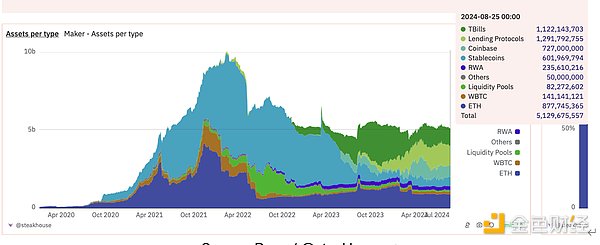
Source: Dune / @steakhouse
3. There are a large number of stablecoins circulating in the market. In a high-interest environment, holders do not get any benefits at all, and are actually paying opportunity costs. Centralized stablecoins privatize profits and socialize losses. More types of RWA assets are needed to effectively utilize these stablecoins, generate returns for users, and bring more liquidity to the DeFi market.
4. For large, well-known asset management companies such as Franklin Templeton and WisdomTree, tokenization represents the opening of new distribution channels to reach new customer groups who prefer to store their assets digitally on the blockchain rather than in traditional brokerage or bank accounts. For them, tokenized treasury bonds are their "beachhead market".
5. The traditional financial sector is increasingly focusing on combining with DeFi technology, reducing costs and increasing efficiency through asset tokenization, and solving inherent problems in traditional finance. Mapping real-world assets (such as stocks, financial derivatives, currencies, equities, etc.) to the blockchain not only expands the scope of application of distributed ledger technology, but also makes the exchange and settlement of assets more efficient. In addition to exploring new distribution channels, it focuses more on the significant efficiency improvements and innovations that technology brings to the traditional financial system.
●The asset size of RWA chain is about 12 billion, and the total market value of stablecoins exceeds 180 billion US dollars.Digitizing traditional financial assets through blockchain technology can not only improve transparency and efficiency, but also attract more users to enter this emerging market. According to reports from 21.co, Citi and IMF, the total value of tokenized assets is expected to grow to 6.8 trillion US dollars in 2030 under basic market conditions.
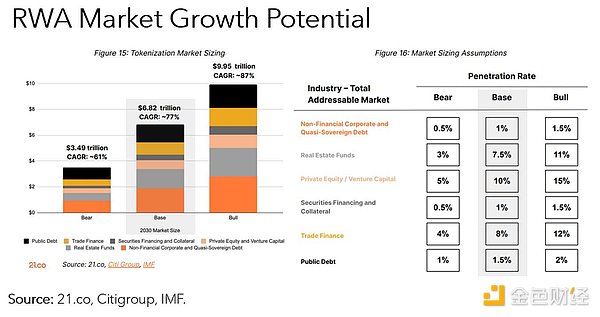
Source: 21.co, Citigroup, IMF
● Private credit and US Treasuries are the main assets for tokenization - these two markets have grown from millions of dollars to a total loan value of US$8.8 billion in the lending market (63% annual growth) and a Treasury market of over US$2 billion (2100% annual growth) respectively. Tokenized Treasuries remain an emerging field with huge potential — Franklin Templeton, BlackRock, and Wisdomtree are early leaders in this space.
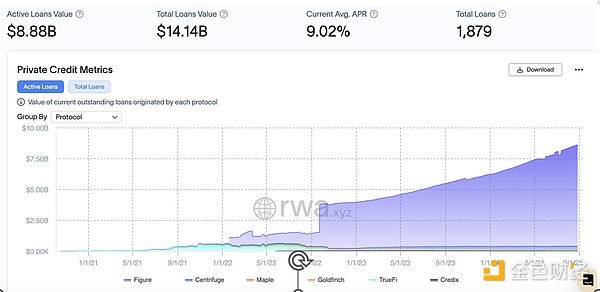
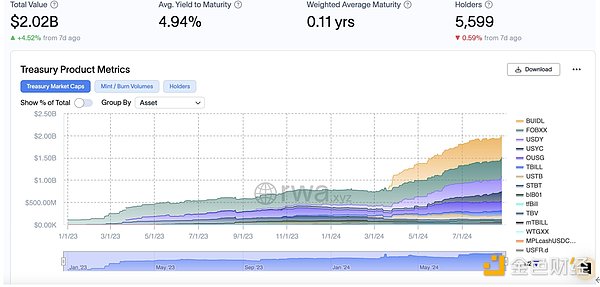
Source: rwa.xyz
● The Fed’s policies have a direct and significant impact on the expansion and landscape of the RWA DeFi sector:
● In Q3 2022, private credit-backed RWAs accounted for 56% of total RWA TVL, while Treasuries-backed RWAs had a 0% share.
In Q3 2023, the share of private credit-backed RWAs in total RWA TVL fell to 18%, while the share of Treasuries-backed RWAs rose to 27%.
At the end of August 2024, as of the publication of this article, private credit-backed RWAs accounted for 76% of total TVL, and the share of Treasuries-backed RWAs stabilized to 17%.
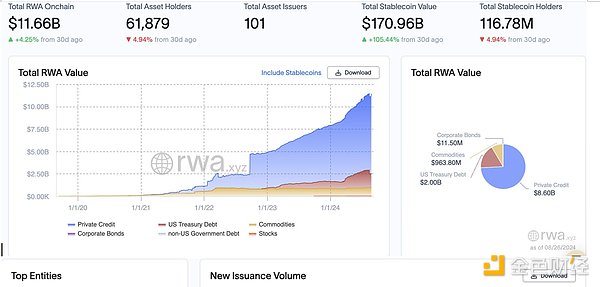

Source: 1) Market Drivers: The growth of yield-earning (interest-bearing, fixed-income) RWAs is rapid. Since 2024, the on-chain value of non-stablecoin RWAs has increased by $4.11 billion, mostly from government bonds, private credit, and real estate tokens. The current overall growth and ecosystem improvement are mainly attributed to the following three aspects: Institutional interest and new products, for example, BlackRock, Superstate and other institutions launched new on-chain government bond products and T-bills funds.
Ondo launches USDY, Centrifuge's collaboration with Maker and BlockTower, etc.
Improved infrastructure, for example
M^0 Labs develops institutional-grade stablecoin middleware that can be used as a building block for other products.
Ondo Global Markets creates a two-way system to enable seamless transfers between on-chain tokens and off-chain accounts.
Combination with DeFi, for example
Morpho allows the creation of non-custodial vaults to pass RWA returns to DeFi users; combined with Centrifuge to support mortgage lending.
TrueFi launched Trinity, allowing users to deposit tokenized U.S. Treasury bonds as collateral to mint assets pegged to the U.S. dollar that can be used in DeFi.
DAO's asset diversification (Maker)
Given the latest statement by Fed Chairman Powell, the Fed has sent a dovish signal for the first time since the start of the rate hike cycle, indicating that its focus is shifting from controlling inflation to supporting economic growth and employment. The trend of a rate cut cycle has gradually formed, which is expected to stimulate the return of leveraged funds. At present, the CME Fed Observation Tool shows that a 25 basis point rate cut in September is the most likely. However, the August CPI and non-agricultural data are about to be released. If the data exceeds expectations, the probability of a 50 basis point rate cut in September will increase.
T-bill will still be the first choice for idle funds under the continued high interest rate policy, and the trend of continuous rate cuts will have a far-reaching impact on the market. On the one hand, the low interest rate environment may stimulate investors to seek higher-yield opportunities and drive funds into the high-yield DeFi field. On the other hand, the decline in the yield of traditional assets may prompt more RWA to be tokenized in order to seek higher returns on the DeFi platform. By then, the market competition pattern may change, and more capital will flow into high-yield RWA application scenarios combined with DeFi technology, further promoting the development of the entire on-chain economy.
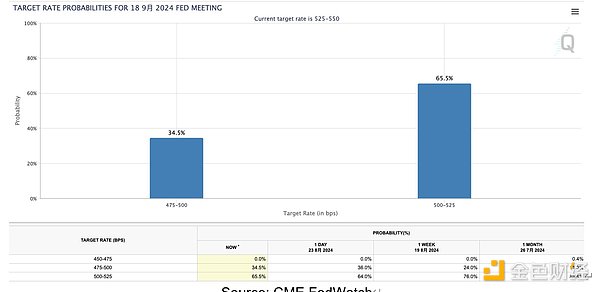
Source: CME FedWatch
According to Galaxy Digital's 2023 full-year statistics, most of the on-chain demand for RWA is driven by a small number of native cryptocurrency users, rather than new cryptocurrency adopters or traditional financial users turning to the chain. Most of these addresses interacting with RWA tokens were active on the chain before these assets were created. The following data is analyzed only for addresses holding tokenized treasuries and mainstream private credit assets:
● Unique addresses: As of August 31, 2023, there were 3,232 UAs holding RWA assets. On August 26, 2024, there were 61,879 holding addresses, an increase of 1,815%.
● Average age of addresses: 882 days (about 2.42 years), indicating that these users have been active since around April 2021.
● Average age of RWA: 375 days, indicating that these assets are relatively new compared to the addresses.
● The oldest address interacting with RWA dates back to March 22, 2016, which is 2,718 days old.
● The distribution shows that the wallet addresses are concentrated around 700-750 days old.
Number of addresses by age group:
● <1 year: 17% (545 addresses)
● 1 to 2 years: 27% (885 addresses)
● 2 to 3 years: 36% (1,148 addresses)
● 3 years and above: 20% (654 According to the Transak report, the total number of RWA token holders on the Ethereum chain alone exceeded 97,000 in mid-2024, with a total of more than 205,000 unique addresses. These tokens have added about 38,000 holders in the past year. Since the beginning of 2024, the overall DEX trading volume of RWA tokens has also seen a significant increase. The DEX trading volume in December 2023 was about US$2.3 billion, and it soared to more than US$3.6 billion in April 2024.
Since 2024, as traditional financial institutions have significantly increased their adoption of RWA, we can foresee that more and more traditional financial users will gradually enter the encryption field, bringing new growth momentum and incremental funds.
The tokenized RWA market is divided into six categories according to asset categories, and the ranking order according to market capitalization is: stablecoins, private credit, government bonds (US bonds), commodities, real estate, and equity securities:
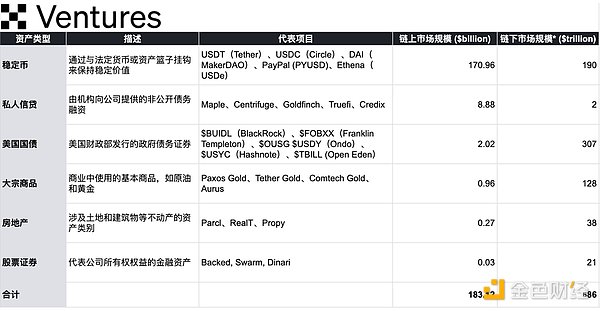
Source: OKX Ventures, rwa.xyz, Statista, 21.co
Stablecoins
Stablecoins have demonstrated clear product-market fit (PMF) in the market and created significant monetization opportunities. For example, in the first quarter of this year, although Tether's assets under management were only a fraction of Blackrock's ($70 billion vs. $8.5 trillion), its profits exceeded Blackrock's ($1.48 billion vs. $1.16 billion).
The current market value of stablecoins is about 170 billion US dollars, with a monthly transaction volume of up to 1.69 trillion, more than 17 million monthly active addresses, and a total number of holders exceeding 117 million.
● Centralized stablecoins still occupy an absolute dominant position: USDT accounts for nearly 70% of the market share, about US$114.57 billion; USDC accounts for 20%, with a market value of about US$33.44 billion;
● The market share of decentralized stablecoins remains stable: DAI accounts for 3%, with a market value of about US$5.19 billion; Ethena accounts for 2%, with a market value of about US$3.31 billion;
● There are approximately 21.63 billion stablecoins stored in centralized exchanges, accounting for 13.2% of the total supply; the remaining circulation, approximately 48.38%, is on Ethereum, 35.95% is on Ethereum, and about 1%-3% is on BSC, Arbitrum, Solana, Base, Avalanche, and Polygon chains respectively.
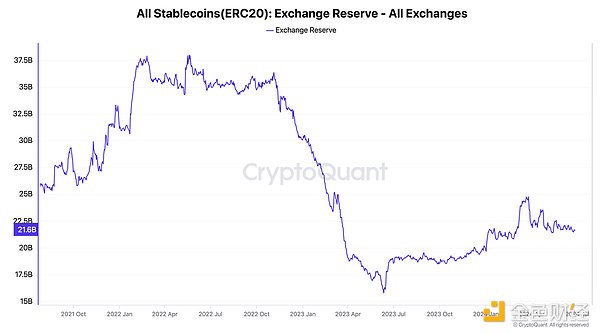
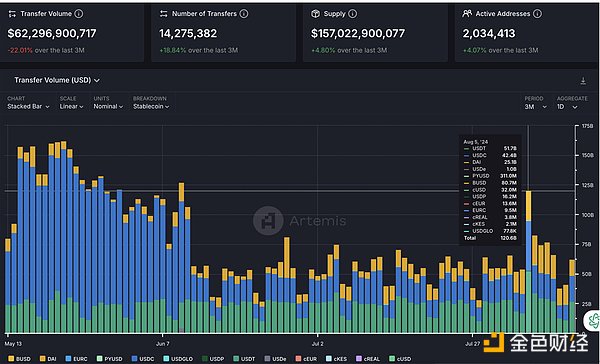
Source: CryptoQuant, Artemis
● Imbalanced value distribution: Centralized stablecoins tend to privatize profits but socialize potential losses, resulting in uneven distribution of benefits.
● Lack of transparency: Centralized stablecoins like Tether and Circle have serious transparency issues, and users are forced to take unnecessary risks. For example, during the SVB bankruptcy, the market had no way of knowing whether Circle or Tether had any financial exposure to SVB, nor was it clear in which banks their reserves were held. Similarly, Tether has been using part of its reserves for lending and investment activities. According to the audit report issued by TBO, about 6.5% of the reserves have been loaned out, about 4% are invested in precious metals, and about 2.5% are classified as other investments. This mode of operation of Tether makes it vulnerable to bank runs, and liquidity crunch may become a potential black swan event.
● Decentralized stablecoins have limited scalability: Decentralized stablecoins face scalability challenges because they typically require overcollateralization of large amounts of assets. As the demand for stablecoins grows, relying solely on a single crypto asset as collateral may not be able to meet demand. In addition, poorly designed algorithmic stablecoins have failed many times, exposing the risks of insufficient collateral and unstable mechanisms.
● Ethena: Offers a relatively high APY of up to 12.2%, with a current sUSDe TVL of approximately 1.7 billion; its market value has increased by 978% since its launch at the beginning of the year. The Delta Hedge strategy adopted by Ethena is particularly attractive in a bull market environment. With long positions dominating, funding rates are generally favorable for short holders. This strategy allows Ethena to remain stable while attracting traders who want to hedge against market volatility and profit from positive funding rates during bull markets.
● Maker (now Sky): APY 7.7%, current sDAI TVL is about 1.3 billion; more than 2 billion DAI deposited in DSR, 38% of all DAI in circulation, deposits have increased by 197% since founder Rune announced a yield of up to 8% last August, and the market value has stabilized at just over $5 billion. The collateral TVL is $7.74 billion and the collateral ratio is 147%. Maker integrates U.S. Treasuries into its portfolio, diversifying its revenue sources and enhancing revenue stability. Integrate pledged stETH and use it as collateral to mint DAI. It also lifted the 15% slashing penalty for staking, promoting stability and aligning the interests of holders with the sustainability of the ecosystem.

Source: Dune / @stablescarab
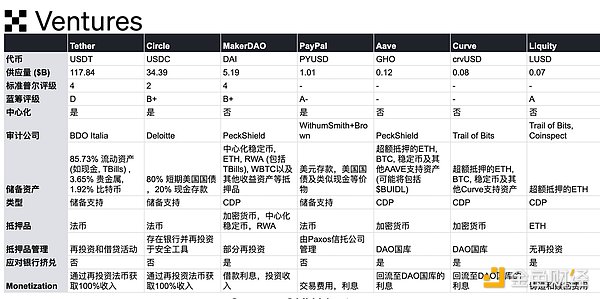
Source: OKX Ventures
● DAI has thrived largely on the huge subsidies paid by Curve holders to 3pool, providing a strong moat. As Maker transforms into a more centralized Sky ecosystem, this strategy, while pragmatic, has sparked widespread controversy in the community. Many people worry that the shift to USDS will cause Maker to lose its original decentralized advantage and eventually be swallowed up by more reliable alternatives. Whether it can realize its vision of combining US debt and subDAO models to rapidly scale the Sky ecosystem remains to be seen.
● In contrast, Liquity has chosen a completely opposite path. Its v2 $BOLD, a fully Ethereum-native stablecoin backed only by ETH (and LST), will attract a large amount of collateral according to the current mechanism. Will the insistence on maximum decentralization and elasticity of CDP make it a niche market product? We look forward to users voting with their real money.
● The increasing popularity of low-volatility assets in the stablecoin field. After the education of the last cycle, the market has become more conservative and rigorous in the underlying risk control of crypto-financial assets, especially in the selection of collateral and risk control measures behind currency issuance. Most of the high-risk algorithmic stablecoin projects represented by LUNA, which used high volatility and endogenous assets as collateral in the last cycle, have disappeared.
● Due to the clear and simple business lines, the regulatory costs are more controllable and consistent. Large financial companies are beginning to target relatively profitable and easy-to-enter stablecoin businesses. Paypal's PYUSD has reached a circulation of 1 billion, and its market value has increased by 155% since it announced its entry into Solana on May 29. The supply of PYUSD on the Solana chain has also increased by nearly 4685%. Similarly, JD.com's plan to launch a stablecoin pegged to the Hong Kong dollar is also an attempt to get a piece of the pie while seeking new growth points for digital finance.
● Circle is still waiting for more legislative guidance, especially on reserve reporting and liquidity requirements. Circle has always emphasized transparency and switched from Grant Thornton to Deloitte for audits to increase confidence in its reserves. Tether's transparency issue has long been controversial. Although Tether claims that all of its USDT is backed by an equivalent amount of fiat currency reserves, there has been a lack of transparency about the specific details and independent audits of its reserves. In 2024, US regulators are pushing for more transparency and compliance requirements, and Tether is expected to be subject to these requirements as well.
Private Credit:
Through the tokenization of credit agreements, financial institutions provide loans to companies through debt instruments.
In traditional finance, private credit is a huge market worth $1.5 trillion. Crypto credit protocols have tokenized more than $13 billion in loans, and more than $8 billion is currently loaned to real-world businesses, creating returns for on-chain lenders. For on-chain traders, private credit is attractive due to its higher yield potential. For example, lending stablecoins through protocols such as Centrifuge can earn an average annualized yield of 8.7%, exceeding the usual 4-5% annualized yield of platforms such as AAVE, but of course the risk also increases.
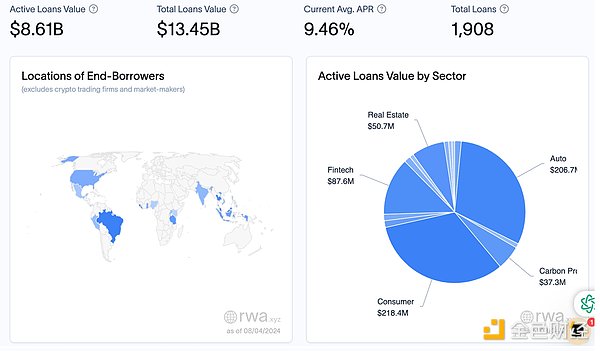
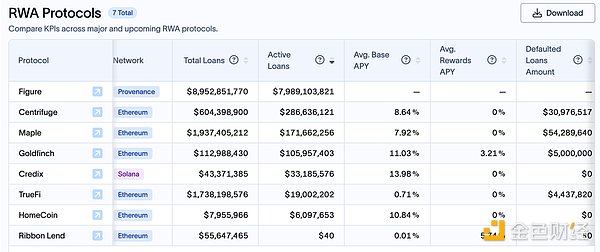
Source: r wa.xyz
Of the entire loan portfolio, Consumer loans accounted for the largest proportion of $218.4M, showing its strong demand in the overall loan. Automotive industry loans followed closely with an amount of $206.7M. Fintech industry loans amounted to $87.6M, which, despite a relatively small share, showed rapid growth, reflecting the impact of technological innovation on the financial market. Real estate - including residential and commercial real estate financing ($50.7M) and carbon project financing ($37.3M) accounted for a smaller proportion, but also played an important role in their specific fields.
The advantages of on-chain credit issuance and distribution are most clearly reflected in the significantly reduced capital cost. The more efficient institutional DeFi infrastructure can significantly save capital costs and provide new distribution channels for existing and new private credit products. Driven by the tightening of banking business, an important niche market is being opened up in the traditional financial sector. This shift toward non-bank lending provides good opportunities for private credit funds and other non-bank lenders, attracting the interest of pension plans and endowments seeking smoother, higher returns.
Private credit as a part of alternative assets has grown significantly over the past decade, and although it currently accounts for a relatively small proportion of the global debt market, it is an expanding market with huge room for growth.
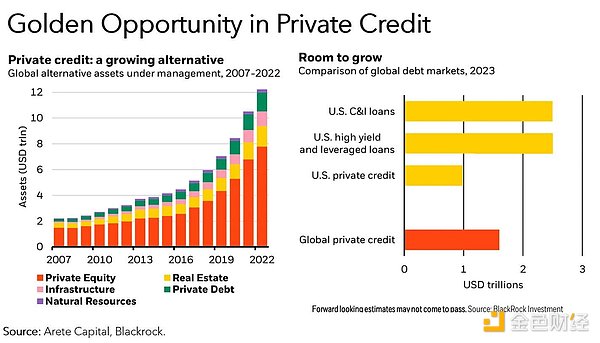
Financing needs:
Enterprises: In the real world, many enterprises (especially small and medium-sized enterprises) need low-cost financing to support operations, expansion or short-term capital turnover.
Difficulty in Financing: The loan procedures of traditional financial institutions are complicated and time-consuming, making it difficult for companies to quickly obtain the funds they need.
Tokenization of Credit Agreements:
Tokenization: By tokenizing credit agreements, financial institutions can convert debt instruments into tokens that can be traded on the chain. These tokens represent debt instruments such as loans or accounts receivable of enterprises.
Simplified Process: Tokenization simplifies the financing process, allowing companies to obtain funds faster and more efficiently.
Related Opportunities:
High Yield: Investing in private credit can usually earn higher returns than traditional debt instruments because companies are willing to pay higher interest rates in exchange for quick financing.
Diversified Portfolio: Private credit provides users with diversified opportunities and spreads risks.
Risks and Challenges:
Difficulty in Understanding: Users may find it difficult to understand the working mechanism of private credit, especially the part involving off-chain assets.
Default Risk: Users are worried that borrowers may run away, resulting in loan defaults. In particular, if the audit of off-chain assets is not transparent, borrowers may use a receivables voucher to borrow money on multiple platforms, increasing the risk of default.
1.Maple Finance: Provides on-chain private credit, provides rapid financing for enterprises through tokenized credit agreements, and provides high-yield investment opportunities for lenders, Similar models include TrueFi (which also provides US Treasury products like Maple) and Goldfinch.
2.Centrifuge: Matching platform; Tokenize accounts receivable and other debt instruments, match lenders and borrowing companies through on-chain markets, simplify financing processes, reduce financing costs, meet the credit needs of small and medium-sized enterprises.
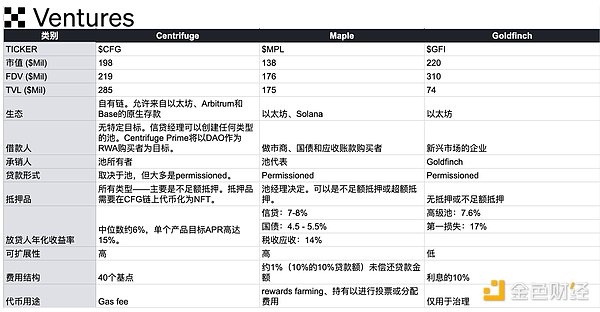
Source: OKX Ventures
● Automatic payment by smart contract: After the predefined conditions are met, the smart contract can automatically issue payments to suppliers. Set a clear default handling mechanism, which is automatically triggered by the smart contract to protect the interests of users.
● InvoiceTokenization: Invoices can be tokenized to facilitate their transactions and provide liquidity for suppliers.
● Transparent Audit: Blockchain provides an immutable ledger, which simplifies auditing and due diligence. However, it is still necessary to conduct strict audits of off-chain assets through independent third-party auditing agencies to ensure the authenticity and uniqueness of assets and reduce the risks of multi-platform borrowing.
● Risk Assessment: Introduce a credit scoring system based on the chain to conduct risk assessment on borrowing companies and help users make more informed decisions.
● Transactions are slow and opaque:Blockchain improves transparency and speeds up transactions in supply chain finance, benefiting all parties involved.
● Transaction costs are high:Smart contracts can automate many processes in supply chain finance, reducing paperwork and middlemen, thereby reducing costs.
● Credit channels:DeFi can provide more democratic financing channels for small and medium-sized enterprises (SMEs) that traditionally have weak bargaining power.
3. Treasury products:
Tokenized government debt instruments. Referring to the concept of ETF, this type of asset can be likened to BTF (Blockchain Transfer Fund). The RWA U.S. Treasury product tokens on the chain represent the right to hold and distribute the income generated by these debts, rather than the ownership of the Treasury itself, which involves more deposits and withdrawals and compliance issues.
In a high-interest environment, some cryptocurrency players have begun to focus on traditional financial assets to achieve configuration diversification. As interest rates rise, demanders seek safe and stable-yielding assets, and products like Treasury bonds naturally become their choice.
The wave of adoption of tokenized Treasury bonds is driven by the following two factors: fewer DeFi income opportunities (because of lower demand for on-chain leverage); and traders' shift in demand for short-term monetary-like instruments that benefit from tight U.S. monetary policy. This trend is also reflected in the large inflow of off-chain bank deposits into money market funds, driven by low bank deposit rates and long-term exposure to unrealized asset losses. The emergence of institutional DeFi infrastructure is expected to further drive the growing global demand for safe, income-generating and liquid real-world assets.
The shape of the current yield curve indicates higher short-term interest rates and lower long-term interest rates. Most products choose to hold 1-month to 6-month Treasury bills, and some even hold overnight reverse repo and repo securities in search of higher returns.
"Fast", "complete" and "deep" are the core advantages of the OKX Web3 plug-in wallet.
 JinseFinance
JinseFinanceAccording to Dune Analytics data, RWA narratives have ranked second in growth this year, up 117%, second only to Meme. This article will comprehensively sort out the development status and future opportunities of the RWA track.
 JinseFinance
JinseFinanceBuilding a system that supports trustless global transactions will always be an uphill battle, but I have always expected that most Bitcoin holders will remain focused on that goal. Instead, today’s Bitcoin community is focused on petty bickering and infighting.
 JinseFinance
JinseFinanceCore DAO (CORE) surges by 220% in a week, reaching 55th in market cap. Core blockchain innovates with Satoshi Plus consensus, fostering Web3 community. Recent rally fueled by Bitcoin halving anticipation, non-custodial staking launch, and coreBTC introduction, trading at $2.69.
 Xu Lin
Xu LinThe National Bitcoin Office of El Salvador (ONBTC) issued a statement stating that the Bitcoin bond "Volcano Bond" has been approved by the El Salvador Digital Assets Commission and is expected to be issued in the first quarter of 2024.
 JinseFinance
JinseFinanceThe Consensus Layer (CL) client teams discussed the progress of testing the upgrade on an All Core Developers Consensus Call (ACDC).
 Bitcoinist
BitcoinistAn investigation was launched against Core Scientific over claims that its leadership had been involved in securities fraud and activities that negatively affected its stock price.
 decrypt
decryptThe four biggest US-based mining operations - Core Scientific, Marathon Digital Holdings, Riot Blockchain, and Stronghold Digital Mining - got ...
 Bitcoinist
BitcoinistBitcoin contributor, Matt Corallo, expressing his thoughts on Bitcoin maximalists, stated that every other culture aside from promoting BTC should ...
 Bitcoinist
BitcoinistThe Nasdaq-listed Bitcoin miner expects to generate $50 million in annual revenue once the ASIC servers are fully operational.
 Cointelegraph
Cointelegraph